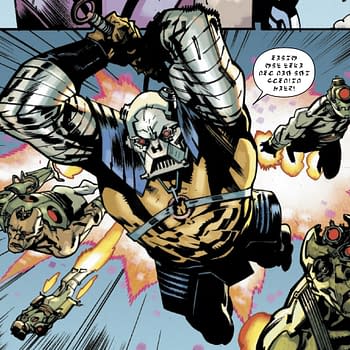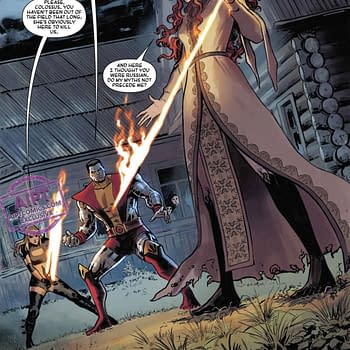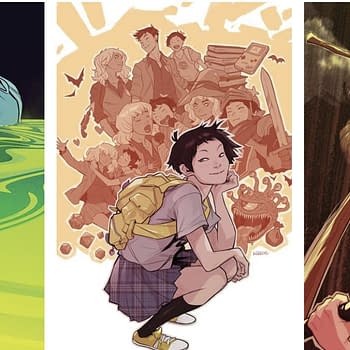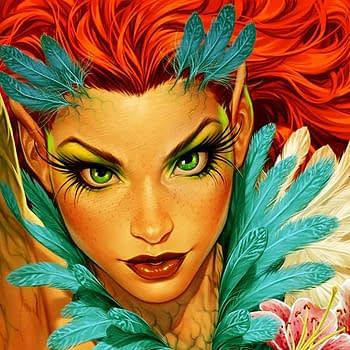Posted in: Comics | Tagged: Best Comics of 2015, Comics, entertainment
Bleeding Cool's 11 Best Comics of 2015
What makes a comic worthy of a "Best of" list? Uniqueness. I'm sure we can all agree that it's easy for our pull lists to grow longer and longer. We read new comics every Wednesday, but not all of them make the same impression. This year Rich Johnston and Christine Marie give you 11 comics to reflect on as we wave goodbye to 2015 and welcome 2016 with open arms.
I Hate Fairyland #1, from Image Comics, written and illustrated by Skottie Young.
This comic has it all. Bright, edgy illustrations and a script that is a guaranteed laugh out loud read. After wishing to be sent to a magical land, main character Gertrude is sent to Fairyland, but her reaction to that isn't what you'd typically expect. Her arrival is turbulent, and although she's greeted by a plethora of fascinating characters, Queen Cloudia, an her guide Larrigon Wentsworth III, Gertrude has a hard time adjusting. However, we don't exactly get to know how things played out after that initial landing. Young throws us twenty-seven years into the future. While she may look like she hasn't aged a day, the sweeter innocent looking Gertrude is no longer filled with hope. She's a feisty girl with a fiery spirit, making her one of the more memorable characters I've encountered in 2015. This issue was the start of something unique, and I look forward to having a future issue in the "Best of 2016" list. That's how confident I am.
Grindhouse: Drive In Bleed Out #8 from Dark Horse Comics by Alex DeCampi, John Lucas and Ryan Hill.
Years ago, Alex De Campi helped create a comic called Commercial Suicide, featuring the grossest, most terrible, most offensive comics possible. Compared to this year's Grindhouse stories, they were up there with her My Little Pony comics. My stomach still turns thinking about the story one of the most sexually explicit-yet-totally plot driven comics I have ever read, but it was its final issue, complete with Milo Manara cover that totally ripped any measure of good taste apart, considering it gave us extreme sex and violence together (in space), including both female circumcision, impromptu genital surgery and an even greater mutilation before revealing that the truth behind the tragedies was even crueller. Quite completely the most targeted exploitative comic book I have read and a comic book masterpiece in manipulating my emotions and challenging my willingness to read the page.
Airboy #2 from Image Comics, by James Robinson and Greg Hinkle
If Grindhouse attempted to exploit the very worst, then Airboy took that intent and turned it on the creators. A metaphysical trip to expose the ego of the creator,. It ruffled all manner of feathers on publication but for all that, was one of the bravest comics I've read since Joe Matt's Peepshow and he didn't know what the hell he was doing. And in issue 2, it took the creators to their lowest, on a drug fuelled sexually explicit destructive journey with a hallucinated comic book character who was not their own but who they were doing anything they wanted with, as a comment upon the comic book industry as a whole. And yet somehow not making us utterly loathe them.
Providence #5 from Avatar Press, by Alan Moore and Jacen Burrows,
Providence #6 may have been the most shocking issue of this run, as the book is read and everything begins to crash down in a truly horrific fashion. But it was the previous issue that saw Alan Moore and Jacen Burrows ramp up the tension, in a story in which little more happens than a man fails to read a book, has a bad dream and goes for a walk. Everything from the branches across a window grasping and entrapping those who walk across it, to the architecture and mid level widescreen shots recalling aspects of The Shining, as so many of HP Lovecraft's works are recreated, stitched together and presented as an inescapable and dread-filled quicksand. It just all happens in the mind and not on the panel, an exercise in restraint that's far more horrific than the real thing. Or so we thought until the next issue.
Klaus #1, from BOOM! Studios, written by written by Grant Morrison with art by Dan Mora.
When I first heard about this comic, I wasn't too thrilled. I assumed a story about a jacked Santa was going to feel forced, and not make much sense. However, I'm happy to say I was pleasantly wrong. After reading a few pages, Klaus quickly skyrocketed into a higher ranking on my pull list. Set in a dark fantastic past of myth and magic, Klaus tells the story of how Santa Claus really came to be. Drawing on Santa Claus' wilder roots in Viking lore and Siberian shamanism Klaus is "Santa Claus: Year One." I tend to enjoy more commercial Santa stuff, stories with heart. Grant Morrison provides us with just that. With the first issue we get a more developed, realistic, brave tale that sets the foundation for a well told story. Besides that, Mora's art is something out of a painting.
Clean Room #1, from Vertigo Comics, written by Gail Simone with art by Jon-Davis Hunt.
There are certain creators that you can expect quality work from. I have a list of them in a side pocket of my brain. When I see their names, I read their work. Now, I'm not saying that it's always something I like, but with a great reputation for good writing, comes great comics. After reading the first issue of Clean Room, I applauded Gail Simone for once again blowing me away with her effective internal dialogue. The story had so many layers to it, I couldn't help but feel ecstatic. Clean Room is a page-turning thrill. The intense psychological thriller follows Astrid Mueller, the enigmatic and compelling guru of a giant self-help organization. However, journalist Chloe Pierce has a problem with Astrid's ways due to the fact that her fiancé Philip didn't react so well to Astrid's books. Now Chloe is on a mission to find out who Astrid Mueller really is. Once again, Simone writes in a way that allows us to get to know characters in a deeper way. She doesn't just state facts about the characters past or present. She makes us think. Davis-Hunt's illustrations are the cherry on top of this tasty ice cream Sunday.
Batgirl #45, from DC Comics, written by Brenden Fletcher and Cameron Stewart, with art by Babs Tarr.
My feelings for Burnside Batgirl have had a rocky journey over the past year. I happened to fall a few issues behind before reading #45, and ended up doing a mini-binge to catch up. Batgirl #45 brings us to the day of Alysia's wedding, and Barbara is the maid of honor! We got to experience bits and pieces of wedding planning over the course of a few issues, but #45 rings the wedding bells. The best part about this issue, and why it's worthy of the list, is the fact that Dick Grayson returns. I of course, would have preferred for the two to run off into the sunset together, but what happened was more important for Barbara's character development. We see her stand up to Dick in a way that she hasn't before. She gets things off of her chest, and it seriously tugs at your heart strings. Another reason this issue is so important, is the wedding that takes place. It's beautifully written and exquisitely illustrated.
Saga #31, from Image Comics, written by Brian K. Vaughan, with art by Fiona Staples.
One could argue that, Hazel is why Saga has so much heart, and Saga #31 shows us what she's been up to. We see how Hazel is doing, and how her life experiences have affected her. We've watched her character develop both emotionally and physically for many issues, so this was an inevitable moment to encounter. Her feelings are shown, emotional turmoil revealed, and her sarcastic personality brought to the forefront. We get to experience what happened back on the ship when we last left Hazel through a flashback, which is really the meat of the issue. Another highlight is the trans character Hazel encounters. It was really something to see that moment through a child's eyes. I thought it was beautifully done in a simple way, and I think that's something to be admired. The issue also brings Izabel back into the picture, who has always been a favorite character of mine. This issue proved that Saga still has an epic creative team behind it capable of surprising readers and enticing them to stick around for more.
Edward Scissorhands #7, from IDW, written by Kate Leth, with art by Drew Rausch.
When we left off with the sixth issue of the Edward Scissorhand series we had met Dr. Wells, whose career is to fix the less fortunate. When Edward sees this, he of course is intrigued by the concept of her possibly being able to help him. Issue #7 focuses on the campaign that Edward's friends put together to get him on Dr. Wells show. It's no surprise that he's invited, but Megs feels hesitant towards the whole thing. I agreed with her character 100%. I think there are so many reasons why people love the character of Edward Scissorhands. It's not just because he's got scissors for hands, it's because despite all he's gone through, despite being trapped in a house alone for most of his life, he's still a kind loving being. With that said, it would be hard to imagine him without his unique quality. The creative team forces us to ask ourselves the question, "Who is Edward without his Scissorhands?" That question is the exact reason why this comic made it to this list. I admire comics that break from the norm and challenge us.
Captain America & The Mighty Avengers #9 from Marvel Comics by Al Ewing, Luke Ross and Rachelle Rosenberg.
It is so, so tempting to call this Multiversity Done Right. But the conclusion to this series, cut short due to the impending Secret Wars event, and designated to deal with the events around the end of the world ahead of said crossover should never ever have been a candidate for this list. But damn it, if it didn't do exactly that. While characters run around the world and/or worlds dealing with the impending catastrophe, we are introduced to a new Avenger, the reader, who is doing their bit to save lives in a first person perspective, in the knowledge that whatever they do, the world is about to end. It is such a surprising turn
Darth Vader #3 from Marvel Comics by Kieron Gillen, Salvador Larroca and Edgar Delgado.
Oh it was so close to being the A-Ha reworking of Phonogram #1 in the list. But no, it would be one of Kieron's other comics, in this case the quite remarkable third issue of his Darth Vader series. The one that had Darth Vader build some more robots, as te character had done in the movie prequels, but this time deliciously evil versions of C-3PO and R2D2 while also introducing Star Wars to a female Indiana Jones for hire character in Aphra. And this issue instantly enriched the series since and helped it become far more a comedy than one might ever have expected, especially against the featureless Vader, with so much gained from a tilt of his helmet. A masterclass in upending expectations.
Bleeding Cool is published by Avatar Press.























